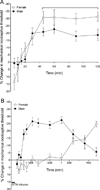Mechanisms mediating nitroglycerin-induced delayed-onset hyperalgesia in the rat
- PMID: 26779834
- PMCID: PMC4738056
- DOI: 10.1016/j.neuroscience.2016.01.005
Mechanisms mediating nitroglycerin-induced delayed-onset hyperalgesia in the rat
Abstract
Nitroglycerin (glycerol trinitrate, GTN) induces headache in migraineurs, an effect that has been used both diagnostically and in the study of the pathophysiology of this neurovascular pain syndrome. An important feature of this headache is a delay from the administration of GTN to headache onset that, because of GTN's very rapid metabolism, cannot be due to its pharmacokinetic profile. It has recently been suggested that activation of perivascular mast cells, which has been implicated in the pathophysiology of migraine, may contribute to this delay. We reported that hyperalgesia induced by intradermal GTN has a delay to onset of ∼ 30 min in male and ∼ 45 min in female rats. This hyperalgesia was greater in females, was prevented by pretreatment with the anti-migraine drug, sumatriptan, as well as by chronic pretreatment with the mast cell degranulator, compound 48/80. The acute administration of GTN and compound 48/80 both induced hyperalgesia that was prevented by pretreatment with octoxynol-9, which attenuates endothelial function, suggesting that GTN and mast cell-mediated hyperalgesia are endothelial cell-dependent. Furthermore, A-317491, a P2X3 antagonist, which inhibits endothelial cell-dependent hyperalgesia, also prevents GTN and mast cell-mediated hyperalgesia. We conclude that delayed-onset mechanical hyperalgesia induced by GTN is mediated by activation of mast cells, which in turn release mediators that stimulate endothelial cells to release ATP, to act on P2X3, a ligand-gated ion channel, in perivascular nociceptors. A role of the mast and endothelial cell in GTN-induced hyperalgesia suggests potential novel risk factors and targets for the treatment of migraine.
Keywords: P2X3; endothelium; mast cells; migraine; nitroglycerin; vascular pain.
Copyright © 2016 IBRO. Published by Elsevier Ltd. All rights reserved.
Conflict of interest statement
The authors report no conflicts of interest.
Figures







Similar articles
-
Role of endothelial cells in antihyperalgesia induced by a triptan and β-blocker.Neuroscience. 2013 Mar 1;232:83-9. doi: 10.1016/j.neuroscience.2012.12.020. Epub 2012 Dec 20. Neuroscience. 2013. PMID: 23262231 Free PMC article.
-
Animal Model of Chronic Migraine-Associated Pain.Curr Protoc Neurosci. 2017 Jul 5;80:9.60.1-9.60.9. doi: 10.1002/cpns.33. Curr Protoc Neurosci. 2017. PMID: 28678396 Free PMC article.
-
Effects of kynurenic acid analogue 1 (KYNA-A1) in nitroglycerin-induced hyperalgesia: Targets and anti-migraine mechanisms.Cephalalgia. 2017 Nov;37(13):1272-1284. doi: 10.1177/0333102416678000. Epub 2016 Nov 16. Cephalalgia. 2017. PMID: 27919017
-
Investigations into the role of nitric oxide and the large intracranial arteries in migraine headache.Cephalalgia. 1997 Dec;17(8):873-95. doi: 10.1046/j.1468-2982.1997.1708873.x. Cephalalgia. 1997. PMID: 9453277 Review.
-
Effects of glyceryl trinitrate and calcitonin gene-related peptide on BOLD signal and arterial diameter: methodological studies by fMRI and MRA.Dan Med J. 2012 Jul;59(7):B4489. Dan Med J. 2012. PMID: 22759854 Review.
Cited by
-
Enhanced post-traumatic headache-like behaviors and diminished contribution of peripheral CGRP in female rats following a mild closed head injury.Cephalalgia. 2020 Jun;40(7):748-760. doi: 10.1177/0333102420907597. Epub 2020 Feb 20. Cephalalgia. 2020. PMID: 32077327 Free PMC article.
-
Sex differences in neuroimmune and glial mechanisms of pain.Pain. 2021 Aug 1;162(8):2186-2200. doi: 10.1097/j.pain.0000000000002215. Pain. 2021. PMID: 34256379 Free PMC article. Review.
-
Neuronal and non-neuronal TRPA1 as therapeutic targets for pain and headache relief.Temperature (Austin). 2022 May 29;10(1):50-66. doi: 10.1080/23328940.2022.2075218. eCollection 2023. Temperature (Austin). 2022. PMID: 37187829 Free PMC article. Review.
-
Metabolic assessment of a migraine model using relaxation-enhanced 1 H spectroscopy at ultrahigh field.Magn Reson Med. 2018 Mar;79(3):1266-1275. doi: 10.1002/mrm.26811. Epub 2017 Sep 17. Magn Reson Med. 2018. PMID: 28921630 Free PMC article.
-
Insulin-like growth factor-1 inhibits nitroglycerin-induced trigeminal activation of oxidative stress, calcitonin gene-related peptide and c-Fos expression.Neurosci Lett. 2021 Apr 23;751:135809. doi: 10.1016/j.neulet.2021.135809. Epub 2021 Mar 10. Neurosci Lett. 2021. PMID: 33713748 Free PMC article.
References
-
- Asghar MS, Hansen AE, Amin FM, van der Geest RJ, Koning P, Larsson HB, Olesen J, Ashina M. Evidence for a vascular factor in migraine. Ann Neurol. 2011;69:635–645. - PubMed
-
- Bartsch T, Knight YE, Goadsby PJ. Activation of 5-HT(1B/1D) receptor in the periaqueductal gray inhibits nociception. Ann Neurol. 2004;56:371–381. - PubMed
-
- Blackwell DL, Lucas JW, Clarke TC. Summary health statistics for U.S. adults: national health interview survey, 2012. Vital Health Stat. 2014;10:1–161. - PubMed
-
- Bogaert MG. Clinical pharmacokinetics of nitrates. Cardiovasc Drugs Ther. 1994;8:693–699. - PubMed
Publication types
MeSH terms
Substances
Grants and funding
LinkOut - more resources
Full Text Sources
Other Literature Sources

